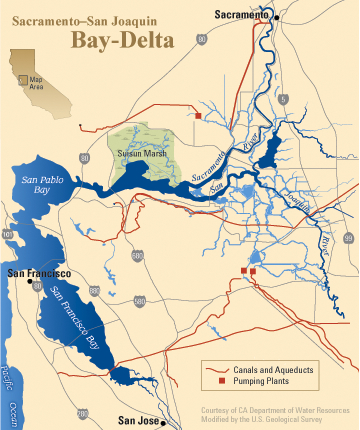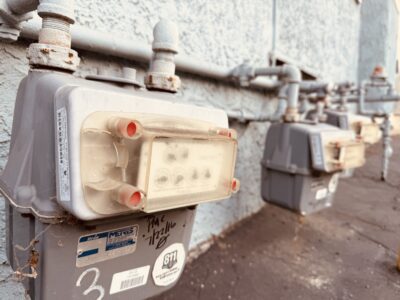The Delta 101: Of Levees, Canals & Whiskey
Nearly four out of five Californians do not know what the Delta is, according to a January 2012 poll. That’s 78 percent of the population. And 86 percent of southern Californians have never heard of it. Yet, 25 million people and 3 million acres of farmland rely on the Delta for at least a portion of their water.
 The Sacramento-San Joaquin River Delta is a vital link in the State’s water system at the confluence of the Sacramento and San Joaquin rivers. I would wager that most Legal Planet readers have heard of the Delta, but if you have not, Aquafornia has a nice summary of “why the Delta matters to every Californian.” And if you don’t know where your water comes from, you can click here to find out.
The Sacramento-San Joaquin River Delta is a vital link in the State’s water system at the confluence of the Sacramento and San Joaquin rivers. I would wager that most Legal Planet readers have heard of the Delta, but if you have not, Aquafornia has a nice summary of “why the Delta matters to every Californian.” And if you don’t know where your water comes from, you can click here to find out.
The Delta is currently a labyrinth of levee-lined tidal channels surrounding sunken islands, but researchers say that its current form is unsustainable. Rising sea level caused by climate change, risk of major earthquakes, subsidence (sinking) of Delta islands, and aging infrastructure all threaten this freshwater resource.
Californians face two major decisions this year regarding the Delta:
1. Whether to adopt the Bay Delta Conservation Plan, a multimillion dollar plan to achieve the “coequal” goals of restoring the ecosystem of the Sacramento-San Joaquin River Delta and ensuring a reliable supply of water for export to southern California – and potentially authorizing a peripheral canal; and
2. Whether to approve a $11.1 billion water bond slated for the November ballot that would provide funds for Delta restoration.
California’s Governor Brown has fast-tracked the Bay-Delta Conservation Plan (BDCP), which will determine how much water needs to stay in the delta and whether a canal or tunnel should be built to move Sacramento River water around the delta for direct transport to the south. Southern California ratepayers would be expected to pay for the canal.
“The real Achilles heel is the financing,” said Sen. Lois Wolk, D-Davis, of the potential new canal or tunnel.
A number of preliminary draft BDCP and environmental review chapters are already available for public review. A new report by the Public Policy Institute of California (PPIC) finds that “a peripheral canal is the best approach for addressing both ecosystem and economic risks.” Instead of pulling water through the Delta to the pumps, a peripheral canal or tunnel would tap water upstream on the Sacramento River and move it around or underneath the Delta. According to PPIC, this would be better for native fish and improve both water quality and water supply reliability. The report largely restates the PPIC’s view from 2008.
 Other stakeholders have concerns about the peripheral canal approach, stating that a peripheral canal would divert water away from the fragile Delta ecosystem, and pull funds away from repairing aging levees in the region – threatening freshwater resources, homes, and agriculture.
Other stakeholders have concerns about the peripheral canal approach, stating that a peripheral canal would divert water away from the fragile Delta ecosystem, and pull funds away from repairing aging levees in the region – threatening freshwater resources, homes, and agriculture.
As for the water bond, Californians may have to wait a bit longer to vote – giving them ample time to learn what the Delta is. In January, Governor Brown indicated that he thinks the measure should be removed from the 2012 ballot and be placed on the 2014 ballot.
The bond proposes about $3 billion for water storage projects, $2.25 billion for delta sustainability, $1.7 billion for ecosystem and watershed protection and restoration, and $1.4 billion for integrated regional water management projects, among other allocations. The bond measure also includes about $2 billion in alleged earmarks.
Interestingly, 60.4% of respondents in the poll referenced above would vote “Yes” in favor of the “Safe, Clean and Reliable Drinking Water Supply Act of 2012” – the $11.1 billion water bond. This seems to highlight the power of positive and clear language in naming ballot measures, rather than any concrete knowledge by poll respondents.
According to a quote often misattributed to Mark Twain, “whiskey’s for drinking and water’s for fighting over.” Those involved in Delta battles may be doing their fair share of both.







Reader Comments